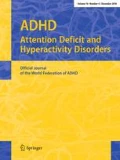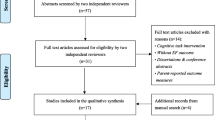Abstract
Children with attention deficit hyperactivity disorder (ADHD) are educated in classrooms along with typically developing children. Those with ADHD, however, find it difficult to participate in routine educational and recreational activities as they encounter problems associated with behaviour, attention, motor skills and physical endurance. Traditionally, the management of children with ADHD has focussed primarily on problems with cognition and has been heavily dependent on pharmaceutical interventions and, to a lesser extent, on non-pharmaceutical measures. More recently, experts have increasingly advocated the use of exercises in alleviating symptoms associated with ADHD. The primary objective of this review was to summarize research that examined the role of exercises on deficits related to attention, motor skills and fitness in children with ADHD. A search of the available literature was conducted using a combination of relevant key words in the following databases: PubMed, MEDLINE, Google Scholar, Embase and Cochrane review. The search filtered 3016 studies of potential relevance, of which 2087 were excluded after screening titles and abstracts as per the inclusion criteria. Thirty-four (34) studies were analysed in greater depth, and 16 were excluded after detailed consideration as they did not match the inclusion (PEDro score > 4) and exclusion criteria. Three (3) additional studies were excluded as they lacked exercise prescription details such as intensity, duration and frequency of exercise. Finally, 15 studies were analysed with a focus on the effects of physical exercises on attention, hyperactive behaviour, motor skills and physical fitness in ADHD children. Overall, the studies reviewed were of moderate-to-high quality and reported benefits of a variety of exercise programmes in improving motor skills, physical fitness, attention and social behaviour in children with ADHD. However, there was limited information regarding school-based programmes, the effects of structured exercise programmes independently or in combination with cognitive-based therapies, and the long-term benefits of exercises in alleviating behavioural problems in these children.

Similar content being viewed by others
References
Ahmed GM, Mohamed S (2011) Effect of regular aerobic exercises on behavioral, cognitive and psychological response in patients with attention deficit-hyperactivity disorder. Life Sci J 8(2):366–371
Berger I, Dor T, Nevo Y, Goldzweig G (2008) Attitudes toward attention-deficit hyperactivity disorder (ADHD) treatment: parents’ and children’s perspectives. J Child Neurol 23:1036–1042. https://doi.org/10.1177/0883073808317726
Bhatia MS, Nigam VR, Bohra N, Malik SC (1991) Attention deficit disorder with hyperactivity among paediatric outpatients. J Child Psychol Psychiatry Allied Discipl 32(2):297–306
Boonstra AM, Oosterlaan JJSKJ, Sergeant JA, Buitelaar JK (2005) Does methylphenidate improve inhibition and other cognitive abilities in adults with childhood-onset ADHD? J Clin Exp Neuropsychol 27:278–298
Canada Fitness (1985) Physical fitness of Canadian youth. Government of Cananda, Fitness and Amateur Sport, Ottawa
Chaddock L, Erickson KI, Prakash RS, VanPatter M, Voss MW, Pontifex MB (2010a) Basal ganglia volume is associated with aerobic fitness in preadolescent children. Dev Neuro 32:249–256
Chaddock L, Erickson KI, Prakash RS, Kim JS, Voss MW, VanPatter M (2010b) A neuroimaging investigation of the association between aerobic fitness, hippocampal volume, and memory performance in preadolescent children. Brain Res 1358:172–183 (PubMed: 20735996)
Chaddock L, Erickson KI, Prakash RS, Voss MW, VanPatter M, Pontifex MB (2012) A functional MRI investigation of the association between childhood aerobic fitness and neurocognitive control. Biol Psychol 89:260–268
Chang YK, Liu S, Yu HH, Lee YH (2012) Effect of acute exercise on executive function in children with attention deficit hyperactivity disorder. Arch Clin Neuropsychol 27:225–237
Cho H, JiS Chung S, Kim M, Joung Y (2014) Motor function in school-aged children with attention-deficit/hyperactivity disorder in Korea. Psychiatry Investig 11(3):223–227
Chronis AM, Fabiano GA, Gnagy EM, Wymbs B, Burrows-maclean L, Pelham WE (2001) Comprehensive, sustained behavioural and pharmacological treatment of ADHD: a case study. Cogn Behav Practice 8:346–359
Denckla MB, Rudel RG (1978) Anomalies of motor development in hyperactive boys. Ann Neurol 3:231–233. https://doi.org/10.1002/ana.410030308
Fawkner SG, Armstrong N, Potter CR, Welsman JR (2002) Oxygen uptake kinetics in children and adults after the onset of moderate-intensity exercise. J Sports Sci 20:319–326
Geuze RH (2005) Postural control in children with developmental coordination disorder. Neural Plast 12:183–196
Graham J, Coghill D (2008) Adverse effects of pharmacotherapies for attention-deficit hyperactivity disorder: epidemiology, prevention and management. CNS Drugs 22:213–237. https://doi.org/10.2165/00023210-200822030-00003
Guiraud T, Nigam A, Gremeaux V, Meyer P, Juneau M, Bosquet L (2012) High-intensity interval training in cardiac rehabilitation. Sports Med 42:587–605
Harvey WJ, Reid G (2003) Attention-deficit/hyperactivity disorder: a review of research on movement skill performance and physical fitness. Adapt Phys Act 20:1–25
Hoza B, Smith LA, Shoulberg KE, Linnea SK, Dorsch ET, Blazo AJ, Caitlin MA, George PM (2015) A randomized trial examining the effects of aerobic physical activity on attention-deficit/hyperactivity disorder symptoms in young children. J Abnorm Child Psychol 43(4):655–667. https://doi.org/10.1007/s10802-014-9929-y
Jensen PS, Arnold LE, Swanson JM, Vitiello B, Abikoff HB, Greenhill LL et al (2007) 3-year follow-up of the NIMH MTA study. J Am Acad Child Adolesc Psychiatry 46:989–1002. https://doi.org/10.1097/CHI.0b013e3180686d48
Jeyanthi S, Arumugam N, Parasher RK (2016) Evaluating physical fitness and motor skills in elementary school children with attention deficit hyperactive disorder: a pilot study. Int J Curr Res 8(09):38886–38891
Kang KD, Choi JW, Kang SG, Han DH (2011) Sports therapy for attention, cognitions and sociality. Sports Med 32:953–959
Kaur P, Chavan BS, Lata S (2006) Early intervention in developmental delay. Indian J Pediatr 73(5):405–408
Kosari S, Hemayat-Talab R, Arab-Ameri E, Keyhani F (2013) The effect of physical exercise on the development of gross motor skills in children with attention deficit/hyperactivity disorder. Zahedan. J Res Med Sci 15(2):74–78
Lee SK, Lee CH, Park JH (2015) Effects of combined exercise on physical fitness and neurotransmitters in children with ADHD: a pilot randomized controlled study. J Phys Ther Sci 27:2915–2919
Mahon AD, Stephens BR, Cole AS (2008) Exercise responses in boys with attention deficit/hyperactivity disorder: effects of stimulant medication. J Atten Disord 12(2):170–176
Massicotte DR, Macnab RB (1974) Cardiorespiratory adaptations to training at specified intensities in children. Med Sci Sports Exerc 6:242–246
McKune AJ, Pautz J, Lombard J (2003) Behavioural response to exercise in children with attention-deficit/hyperactivity disorder. Sports Med 15(3):17–21
Mebler CF, Holmberg HC, Sperlich B (2016) Multimodal therapy involving high-intensity interval training improves the physical fitness, motor skills, social behavior, and quality of life of boys with ADHD: a randomized controlled study. J Atten Disord. https://doi.org/10.1177/1087054716636936
Memarmoghaddam M, Torbati HT, Sohrabi M, Mashhadi A, Kashi A (2016) Effects of a selected exercise program on executive function of children with attention deficit hyperactivity disorder. J Med Life 9(4):373–379
Millichap JG (2011) Attention deficit hyperactivity disorder handbook. A physician’s guide to ADHD, 2nd edn. Springer, New York, pp 1–2. ISBN 978-1-4419-1397-5
Moffitt TE, Melchior M (2007) Why does the worldwide prevalence of childhood attention deficit hyperactivity disorder matter? Am J Psychiatry 164(6):856–858
MTA Cooperative Group (1999) A 14-month randomized clinical trial of treatment strategies for attention-deficit/hyperactivity disorder: multimodal treatment study of children with ADHD. Arch Gen Psychiatry 56(12):1073–1086
Mukhopadhyay M, Misra S, Mitra T, Niyogi P (2003) Attention deficit hyperactivity disorder. Indian J Pediatr 70(10):789–792
Oord VDS, Prins PJ, Oosterlaan J, Emmelkamp PM (2008) Efficacy of methylphenidate, psychosocial treatments and their combination in school-aged children with ADHD: a meta-analysis. Clin Psychol Rev 28:783–800. https://doi.org/10.1016/j.cpr.2007.10.007
Piek JP, Pitcher TM, Hay DA (1999) Motor coordination and kinaesthesis in boys with attention deficit-hyperactivity disorder. Dev Med Child Neurol 41(3):159–165
Polanczyk GM, Lima SD, Horta BL, Biederman J, Rohde LA (2007) The worldwide prevalence of ADHD: a systematic review and metaregression analysis. Am J Psychiatry 164(6):942–948
Pontifex MB, SalibaBJ Raine LB, Picchietti DL, Hillman CH (2013) Exercise improves behavioural, neurocognitive, and scholastic performance in children with attention-deficit/hyperactivity disorder. J Pediatr 162:543–551
Rasmussen P, Gillberg C, Waldenstrom E, Svenson B (1983) Perceptual, motor and attentional deficits in seven-year-old children: neurological and neurodevelopmental aspects. Dev Med Child Neurol 25:315–333
Rich EC, Loo SK, Yang M, DangJ Smalley LS (2009) Social functioning difficulties in ADHD: association with PDD risk. Clin Child Psychol Psychiatry 14(3):329–344
Sagvolden T, Johansen E, Aase H, Russell V (2005) A dynamic developmental theory of attention-deficit/hyperactivity disorder (ADHD) predominantly hyperactive/impulsive and combined subtypes. Behav Brain Sci 28:397–419. https://doi.org/10.1017/S0140525X05000075
Sartor F, de Morree HM, Matschke V, Marcora SM, Milousis A, Thom JM (2010) High-intensity exercise and carbohydrate-reduced energy-restricted diet in obese individuals. Eur J Appl Physiol 110:893–903
Schlack R, Hölling H, Kurth BM, Huss M (2007) The prevalence of attention-deficit/hyperactivity disorder (ADHD) among children and adolescents in Germany. Initial results from the German health interview and examination survey for children and adolescents (KiGGS). Bundesgesundheitsblatt Gesundheitsforschung Gesundheitsschutz 50(5–6):827–835
Shiraev T, Barclay G (2012) Evidence based exercise—clinical benefits of high intensity interval training. Aust Fam Phys 41:960–962
Sijie T, Hainai Y, Fengying Y, Jianxiong W (2012) High intensity interval exercise training in overweight young women. J Sports Med Phys Fit 52:255–262
Silva AP, Prado SOS, Scardovelli TA, Boschi SRMS, Campos LC, Frère AF (2015) Measurement of the effect of physical exercise on the concentration of individuals with ADHD. PLoS ONE 10(3): e0122119. https://doi.org/10.1371/journal.pone.0122119
So YH, Oh JW (2008) The influence on participation degree game and aggression on game addiction of physical education college students. J Sport Leis Stud 33:1198–1206
Sonuga-Barke EJ, Brandeis D, Cortese S, Daley D, Ferrin M, Holtmann M, Stevenson J, Danckaerts M, Oord VDS, Dopfner M, Dittmann RW, Simonoff E, Zuddas A, Banaschewski T, Buitelaar J, Coghill D, Hollis C, KonofalE Lecendreux M, Wong IC, Sergeant J, European AGG (2013) Nonpharmacological interventions for ADHD: systematic review and meta analyses of randomized controlled trials of dietary and psychological treatments. Am J Psychiatry 170:275–289
Sperlich B, Zinner C, Heilemann I, Kjendlie PL, Holmberg HC, Mester J (2010) High-intensity interval training improves VO(2 peak), maximal lactate accumulation, time trial and competition performance in 9-11-year-old swimmers. Eur J Appl Physiol 110:1029–1036
Stray LL, Stray T, Tonnessen FE (2009) Motor function neurological assessment (MFNU) as an indicator of motor function problems in boys with ADHD. Behav Brain Funct 5:22–27
Tantillo M, Kesick CM, Hynd GW, Dishman RK (2002) The effects of exercise on children with attention-deficit hyperactivity disorder. Med Sci Sports Exerc 34:203–212
Taylor AF, Kuo FE (2009) Children with attention deficits concentrate better after walk in the park. J Atten Disord 12:402–409
Tremblay MS, Willims JD (2000) Secular trends in body mass index of Canadian children. CMAJ 163:1429–1433
Verret C, Gardiner P, Beliveau L (2010) Fitness level and gross motor performance of children with attention deficit hyperactive disorder. Adapt Phys Act Q 27:337–351
Verret C, Guay MC, Berthiaume C, Gardiner P, Béliveau L (2012) A physical activity program improves behavior and cognitive functions in children with ADHD: an exploratory study. J Atten Disord 16(1):71–80
Wigal SB, Emmerson N, Gehricke JG, Galassetti P (2013) Exercise: applications to childhood ADHD. J Atten Disord 17(4):279–290
Williams CA, Carter H, Jones AM, Doust JH (2001) Oxygen uptake kinetics during treadmill running in boys and men. J Appl Physiol 90:1700–1706
Acknowledgements
I would like to thank Dr. Narkeesh arumugam and Dr. Raju K. Parasher for their valuable suggestions and guiding me in preparing this systematic review.
Author information
Authors and Affiliations
Corresponding author
Ethics declarations
Conflict of interest
The authors declare they have no conflict of interest.
Human and animal rights
It is a systematic review and does not involve human and/or animal participants.
Rights and permissions
About this article
Cite this article
S, J., Arumugam, N. & Parasher, R.K. Effect of physical exercises on attention, motor skill and physical fitness in children with attention deficit hyperactivity disorder: a systematic review. ADHD Atten Def Hyp Disord 11, 125–137 (2019). https://doi.org/10.1007/s12402-018-0270-0
Received:
Accepted:
Published:
Issue Date:
DOI: https://doi.org/10.1007/s12402-018-0270-0




